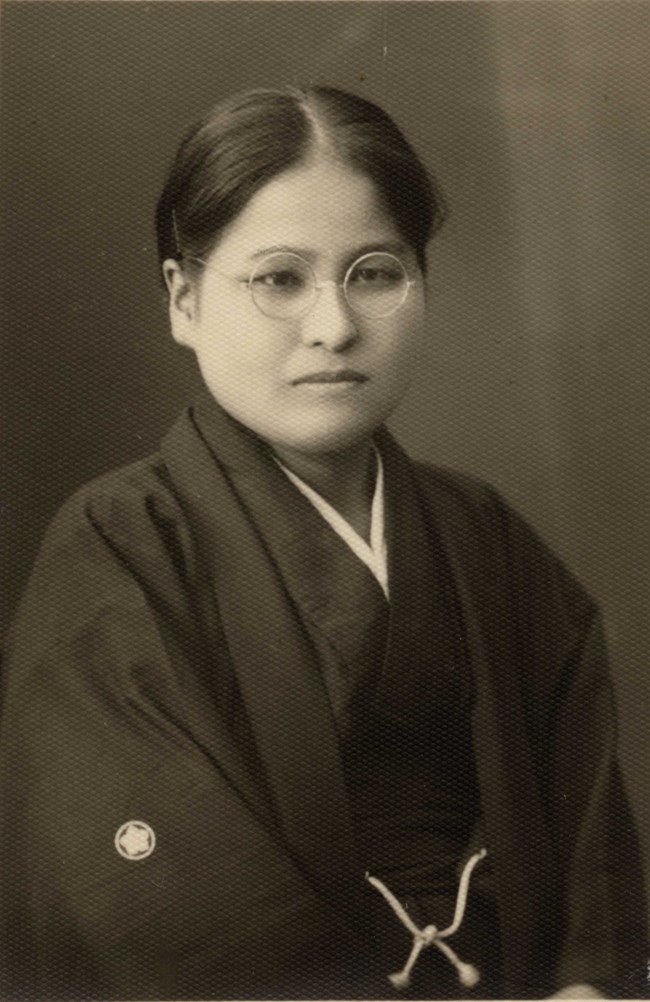Part of a series of articles titled Women's History in the Pacific West - Pacific Islands Collection.
Previous: Kiyome Tsuda
Article

Japanese Cultural Center of Hawai‘i/Konko Mission of Wahiawa Collection
Article written by Brittney Nareau
"We came into this concentration camp for what reason. It is just like dew on the ground.
We are stepped on.
We can’t take our head up.
There are thousands of things to be recalled in our memory.
Months and days spins like the trade-winds."1
Haruko Takahashi
Haruko Takahashi was a Shintō priestess who spent part of World War II imprisoned at Honouliuli Internment Camp on O’ahu, Hawai’i. She was born on April 19, 1910 in Kohala on Hawai’i Island to parents who had immigrated from Japan. Takahashi was a Nisei who held dual citizenship. She lived in Hawai’i when it was a territory of the United States between 1898 and 1959, before seeing the establishment of Hawai’i as a state in 1959. Takahashi’s journey to becoming a Shintō priestess started when she was a teenager. Growing up, Takahashi had poor eyesight that could not be addressed by surgery. She credits her introduction to the Konkokyo (or Konko) religion, a sect of ancient Japanese Shintōism, with the miraculous recovery of her eyesight at the age of seventeen.2 By January 14, 1940, Takahashi had established the Konko Mission of Wahiawa on O’ahu, a branch of the Church of Konko Mission of Honolulu. Just under two years later, World War II changed her life completely.
On December 7, 1941, the Japanese military attacked the Pearl Harbor Naval Base on O’ahu, leading the United States to enter World War II. Almost immediately, martial law was declared in Hawaii and government officials started to round up residents suspected of harboring ill intentions against the United States. A vast majority of the eight hundred residents of Hawaii who were initially assembled, were of Japanese descent, and many were community leaders like Takahashi. The detainees were confined in various existing facilities located on the six major Hawaiian islands and eventually moved to, the U.S. Immigration Station and Sand Island Detention Camp. Many detainees also were sent to mainland Department of Justice and War Relocation camps. The opening of Honouliuli Internment Camp in 1943 provided an alternative to moving detainees to the mainland that was more permanent and isolated.3
Takahashi was arrested early in the raids on December 14, 1941, primarily because of a trip she had made to Japan in 1933.4 Government officials believed her ties to Japan made her sympathetic to Japanese imperial policy and potentially disloyal to the United States. When interrogating Takashi during hearings, the Board of Officers and Civilians asked questions regarding her education in the United States, claiming that she spoke “very little English” despite living in Hawai’i her entire life. They also questioned her religion, unsuccessfully trying to tie Shintōism to worship of the Japanese Emperor. The Board claimed that “in view of her activities as a Shintō priestess and her apparent loyalty to Japan,” she was “dangerous to the public peace, safety, and internal security of this country.”5 She was not allowed an attorney during her incarceration, but she did write letters advocating for her release. Her pleas for justice read like poetry:
Even when we sing our song does not sing like a melody.
Thus clothes can be dyed, for instance, yellow could be dyed
To brown, white, into red, but our heart cannot be pounding if we are aim¬ing for Japan, we can’t think about America.
We are born into this.
The room which we are in is just cold at night,
We dream of our home, also homeland.
Even in the moonlight we can’t walk.
What fun we’re going to have.6
Although the Military Governor’s Review Board denied Takahashi’s request for liberation in March 1944, she was released in July of that year.7 By the end of World War II, more than 2,000 people of Japanese descent from Hawai’i were incarcerated, but none were ever found guilty of acts against the United States.8
Takahashi re-opened the Konko Mission of Wahiawa on January 1, 1948. She made one more pilgrimage to Japan in 1963, to visit the Konkokyo Headquarters in Okayama. She died on December 24, 1972, and her life is still celebrated every year in a memorial service at the Konko Mission.
It is just like a trade-wind, always going around.
When we wear our shoes and walk on the street.
We came here but don’t sit here like a dummy.
Think fast like an arrow, but don’t think what they say.
Think that what you have been taught, but don’t cry, be strong.
You will obey orders, but obey the right ones.9
This project was made possible in part by a grant from the National Park Foundation.
This project was conducted in Partnership with the University of California Davis History Department through the Californian Cooperative Ecosystem Studies Unit, CA# P20AC00946
1 Takahashi, Haruko. 1945. Record Group 489, Entry (A1) 19 Alien Processing Center, 1941-45, Box 97, Takahashi, Haruko, National Archives and Records Administration II, College Park, Maryland.
2 “80th Anniversary Celebration Konko Mission of Wahiawa,” March 15, 2020, accessed June 11, 2021, http://konkomissionshawaii.org/Konko%20Wahiawa%2080th%20Booklet%20FINAL.pdf (PDF, 17,433 KB).
3 “History and Culture” Honouliuli National Historic Site, accessed June 11, 2021, https://www.nps.gov/hono/learn/historyculture/index.htm.
4 National Archives and Records Administration (NARA), Passenger Lists of Vessels Departing from Honolulu, Hawaii, compiled 06/1900 - 11/1954 (Washington, D.C.), RG 85.
5 Amy Nishimura, “From Priestesses and Disciples to Witches and Traitors: Internment of Japanese Women at Honouliuli and Narratives of ‘Madwomen,’” in Social Process in Hawai’i vol 45 (2014): 205.
6 NARA, Passenger Lists of Vessels, RG 85.
7 Nishimura, “From Priestesses and Disciples,” 204.
8 “History and Culture.”
9 NARA, Passenger Lists of Vessels, RG 85.
Rev Haruko Takahashi 48th Memorial Service and Monthly Memorial Service 12 20 20, https://www.youtube.com/watch?v=-EFfG51ZRJw.
Part of a series of articles titled Women's History in the Pacific West - Pacific Islands Collection.
Previous: Kiyome Tsuda
Last updated: December 16, 2024